Are you a Quiet Speculation member?
If not, now is a perfect time to join up! Our powerful tools, breaking-news analysis, and exclusive Discord channel will make sure you stay up to date and ahead of the curve.
Happy New Year! Here's to another year of Modern here on the Nexus. Hopefully you've enjoyed the holiday break as much as I have, but it's time to get back to work and decipher the upcoming set release.
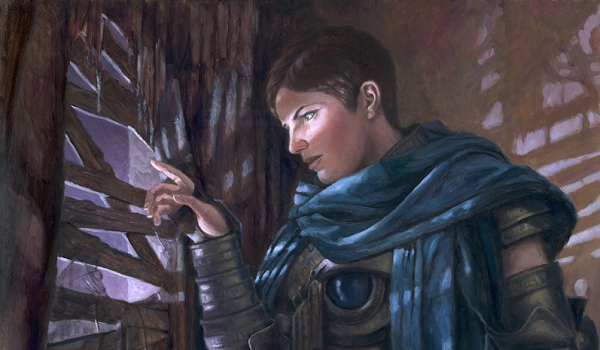
Wizards decided to give us an early Christmas present with Ravinica Allegiance spoilers right before everyone disappeared for the break. There hasn't been anything too groundbreaking so far, though certain mechanics are promising. Cost reduction and alternate casting have been very powerful in the past, so it will be interesting to see if anything comes from spectacle. What we mostly have (as of writing this) are potential cards. In a vacuum potential cards look good enough for Modern, but the real test is context. They need the right deck, metagame, or use to see play irrespective of their power. Today, I'll be blearily squinting at what I think are the two most contextual cards spoiled so far.
Lavinia, Azorius Renegade
The first spoiler that really interests me is Lavinia, Azorius Renegade. I'm glad that Wizards is printing decent hatebears again. It looks like they're finally acknowledging that there need to be answers and that hate cards can be healthy for the game. We've been desperately in need of more answers for some time. The fact that they're in the strategy that I prefer is also a bonus.
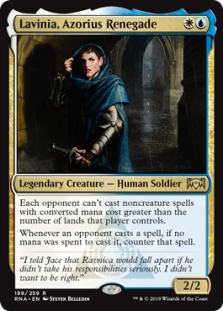 Lavinia stops your opponent from cheating on lands by forcing them to have as many in play as the non-creature spell costs. There have been cards that stop spells based on their mana cost before, but this is the first time I know of where quantity of lands determines castability. That's a weird ability to even describe, now that I'm writing this section. Even if you do have the requisite quantity of land, you'd better have actually paid for that spell if you want it to resolve. I'm look forward to catching some Hollow Ones with that ability.
Lavinia stops your opponent from cheating on lands by forcing them to have as many in play as the non-creature spell costs. There have been cards that stop spells based on their mana cost before, but this is the first time I know of where quantity of lands determines castability. That's a weird ability to even describe, now that I'm writing this section. Even if you do have the requisite quantity of land, you'd better have actually paid for that spell if you want it to resolve. I'm look forward to catching some Hollow Ones with that ability.
Much like Damping Sphere, Lavinia melds several fairly marginal abilities together into a potentially very powerful hate card. The question is where does she belong, and how relevant are these abilities.
Modern Applications
I haven't seen Wizards discuss Lavinia anywhere, but I'm convinced that she was designed with eternal formats in mind. There's nothing for her to do in Standard, as there's little ramp and no free spells. I also can't imagine Wizards making any given how well that usually works out. Her abilities seem tailor made for Legacy and Vintage, where Force of Will and fast mana are everywhere. Vintage in particular has delve spells, Gush, and Black Lotus to answer.
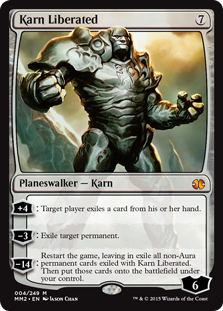 However, that doesn't mean that Lavinia isn't Modern playable. We may not have Sol lands or Lotus Petal, but Tron is very much a deck and Lavinia stops the payoffs. Tron can't power out bombs except for the most answerable one, Wurmcoil Engine, on turn three against Lavinia. In addition she stalls out any combo deck until they have enough lands. It's a shame she doesn't actually counter the storm copies, but preventing Storm from casting Gifts Ungiven or Past in Flames early is powerful. She also stops an early miracled Terminus.
However, that doesn't mean that Lavinia isn't Modern playable. We may not have Sol lands or Lotus Petal, but Tron is very much a deck and Lavinia stops the payoffs. Tron can't power out bombs except for the most answerable one, Wurmcoil Engine, on turn three against Lavinia. In addition she stalls out any combo deck until they have enough lands. It's a shame she doesn't actually counter the storm copies, but preventing Storm from casting Gifts Ungiven or Past in Flames early is powerful. She also stops an early miracled Terminus.
Lavinia doesn't stop anything forever, but delaying spells may be enough. Any deck that would run her will be an aggro or tempo deck with a fast clock and should be able to take advantage of the time she buys. Tempo is everything in Modern, and Lavinia potentially represents a huge tempo swing.
Reality Check
The problem is Lavinia needs to answer this question: Why would I ever play her in a sideboard over Gaddock Teeg? The only commonly played cards I can think of that Lavinia could answer that Teeg wouldn't are Rift Bolt, Bloodbraid Elf, Ancestral Recall, Living End, and Summoner's Pact. Considering the size of the card pool, that's not a long list. Free spells aren't very common in Modern, and this means Lavinia's second ability isn't going to be relevant very often.
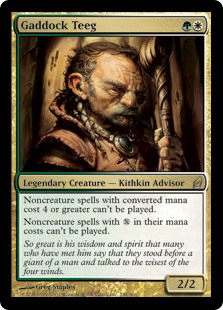 The first ability is very weak compared to Teeg's. Stopping noncreature spells of four or more mana will hit all the same cards as Livinia, but there's no escape clause; Tron could play enough lands to drop Karn Liberated against Lavinia (assuming they're still alive) but not Teeg. Buying time is valuable, but Teeg does far more. In fact, he's so much more versatile that I can't imagine why you'd sideboard Lavinia over him.
The first ability is very weak compared to Teeg's. Stopping noncreature spells of four or more mana will hit all the same cards as Livinia, but there's no escape clause; Tron could play enough lands to drop Karn Liberated against Lavinia (assuming they're still alive) but not Teeg. Buying time is valuable, but Teeg does far more. In fact, he's so much more versatile that I can't imagine why you'd sideboard Lavinia over him.
In addition to stopping Tron cards Teeg also hits Engineered Explosives, Supreme Verdict, Scapeshift, Teferi, Hero of Dominaria, and Conflagrate, to name just a few. There is something to be said for Lavinia being a human, but Humans is already willing and able to stretch for Knight of Autumn and Teeg.
My conclusion is that Lavinia is not going to beat out Gaddock Teeg for sideboard space. Teeg is more reliable, unequivocal, and versatile than Lavinia and her second ability isn't going to be relevant enough of the time to make up the shortfall. Always pick the most powerful sideboard card for the job. I don't see any reason to devote sideboard space to Lavinia over Teeg.
The Catch
There is one special case that pushes Lavinia back toward playability. Any spell that is released from Spell Queller gets played for free, and suddenly Lavinia's second clause is relevant. This 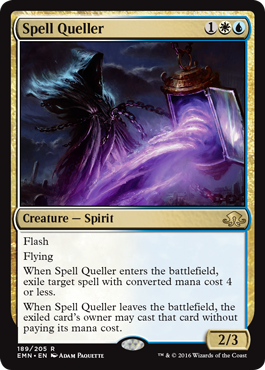 adds an interesting additional use as ablative armor for Queller. Assuming the opponent wants their spell back they'll have to kill Lavinia first, and for removal light decks that is a big ask.
adds an interesting additional use as ablative armor for Queller. Assuming the opponent wants their spell back they'll have to kill Lavinia first, and for removal light decks that is a big ask.
True, this is a fairly marginal effect in the grand scheme of Magic, but given her actual utility as a hatebear it may be enough. Vintage decks run Dack Fayden and Notion Thief not for their devastating combo, but because they're both reasonable cards in the right matchup. Having them on the battlefield at the same time isn't too likely, but either can do plenty of good on its own. You're getting a bonus when it all comes together. By the same token, Lavinia may be borderline good enough to warrant play on her own, but add in the bonus combo with Queller and suddenly she's looking very playable.
The Right Context
I could see myself running Lavinia maindeck in UW Spirits in the right metagame. Thalia, Guardian of Thraben already sees some maindeck play, and given the potential upside of Lavinia alongside Queller, there is an incentive to switch. Thalia's taxing is more widely applicable, but it's often marginal. Lavinia's ability to delay Tron and combo decks is far 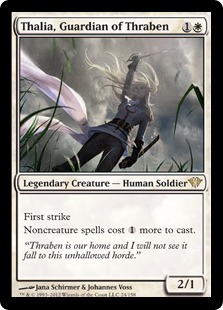 greater. A hatebear's power is sometimes enough to make up for narrowness, so I believe Lavinia could replace Thalia in Spirits.
greater. A hatebear's power is sometimes enough to make up for narrowness, so I believe Lavinia could replace Thalia in Spirits.
Along with the right deck, the right metagame is needed. I'd never want Lavinia in a world of UR Arclight, Humans, and Burn. Thalia is better in almost every way in that metagame. If instead Tron, Storm, Ad Nauseam, and cascade spells define the format, then Lavinia is far better at delaying or defeating those decks. Anything is possible in this shifting metagame, and Lavinia's time may not be far off. This is especially true if I'm wrong and Lavinia was printed to get ahead of something dangerous coming in Standard.
Growth Spiral
The other really interesting card that I'm wresting with is Growth Spiral. 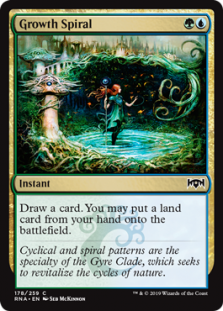 An instant-speed Explore with a trickier mana cost, Growth certainly looks playable enough. Naturally, the discussion has revolved around its use in Amulet Titan, which is the only ramp deck around that could cast it. Everything else is just red and green. Given that Simic Growth Chamber is a four-of and Amulet runs rainbow lands too, it's very playable.
An instant-speed Explore with a trickier mana cost, Growth certainly looks playable enough. Naturally, the discussion has revolved around its use in Amulet Titan, which is the only ramp deck around that could cast it. Everything else is just red and green. Given that Simic Growth Chamber is a four-of and Amulet runs rainbow lands too, it's very playable.
However, I'm skeptical. The additional colored mana is no small cost because Titan doesn't always have Chamber or Gemstone Mine to get that blue. Further, I don't know why instant speed is relevant on a ramp spell. It seems like Growth should be better than Explore, but actually demonstrating why is proving difficult.
Uniqueness
Part of the problem is that instant speed ramp is so rare it's hard to judge. Traditional search-your-library-for-a-land ramp is always sorcery speed. Putting a land from hand into play has 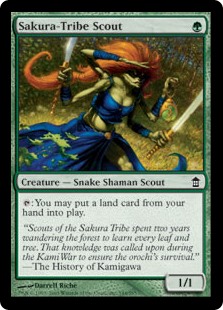 been instant-speed before, but it's not really playable. Only Sakura Tribe Scout sees any play as a ramp spell and only in Amulet Titan. Atarka's Command can do that too, but I've never seen anyone do so and have it be relevant.
been instant-speed before, but it's not really playable. Only Sakura Tribe Scout sees any play as a ramp spell and only in Amulet Titan. Atarka's Command can do that too, but I've never seen anyone do so and have it be relevant.
In my experience, even Scout's ability is really a sorcery, because there's rarely reason to play a land on the end step. I've been gotten when my opponent Scouted in the land to surprise me with Engineered Explosives activations or a Lightning Bolt, sure. However, the purpose of Scout is to ramp off along with Amulet of Vigor into Primeval Titan during the main phase. When that isn't happening the only reason to hold off on Scouting is to use it as a blocker, and while that's not nothing it's not great either. Again, instant is greater than sorcery, but what's the point?
Stretching for Relevance
I don't have an answer, so I asked some actual Amulet players. They unanimously answered that they would absolutely play Growth over Explore if they were playing Explore in the first place (some weren't).  When asked why, they all responded that instant is better than sorcery; when pressed, they struggled to come up with any other reason, especially since Explore isn't always good enough.
When asked why, they all responded that instant is better than sorcery; when pressed, they struggled to come up with any other reason, especially since Explore isn't always good enough.
One person did come up with utility against land destruction. Casting Growth in response to Ghost Quarter or Molten Rain and dropping another bounceland to rescue the target land isn't nothing. However, he conceded that it isn't relevant very often. Most decks run the slower Field of Ruin over Ghost Quarter, and Ponza isn't really a deck anymore. Therefore, I have to conclude that the only additional benefits to Growth over Explore besides instant speed are marginal at best.
Looking Further
If the only benefit to Growth is being instant speed and that's not relevant most of the time then why bother? Frankly, I think that most decks will come to the same conclusion and play the easier to cast Explore. However, that's not the end of the story. Traditionally, ramp decks tapped out every turn to build their mana before tapping out to drop huge bombs and win. This meant they didn't interact, at least early.
 An exception was RUG Scapeshift, a rare control/ramp hybrid. Pre-Twin ban, it was a decent deck because it could cheaply ramp with Sakura-Tribe Elder and Search for Tomorrow and then play essentially the same tempo game as Twin until it was time to kill with Scapeshift. The blue interaction was then dropped for more ramp as speed increased in value. Growth could potentially change things.
An exception was RUG Scapeshift, a rare control/ramp hybrid. Pre-Twin ban, it was a decent deck because it could cheaply ramp with Sakura-Tribe Elder and Search for Tomorrow and then play essentially the same tempo game as Twin until it was time to kill with Scapeshift. The blue interaction was then dropped for more ramp as speed increased in value. Growth could potentially change things.
Growth mitigates the tradeoff between ramp and interaction. Rather than choosing between holding up Remand or dropping Sakura-Tribe, Scapeshift can sit on Remand and if there's nothing to counter ramp with Growth. That flexibility is the real power of instant speed and if there's a home for Growth in Modern, that style of deck will be it. Whether that's actually better than GR Scapeshift with Primeval Titan or in the metagame context is admittedly questionable, but it's certainly possible. And that might be enough.
More to Come
This is just the first trickle of spoilers to wet our whistles. If they're anything to go by, Ravnica Allegiance may prove very powerful, but will definitely be interesting to puzzle through. Here's to an interesting and productive 2019.




What’s your opinion about the sphinx of foresight? I’ve read a lot of different opinions. It’s a mediocre creature for a modern 4 drop, but I also feel like the ability to scry 3 for free on turn one during the upkeep is vastly underrated because of the vanilla creature.
In a deck that needs to hit its curve and needs cards to pitch, let’s say to collective brutality, doesnt this fit the bill perfectly?
That’s another card that seems like it should be really strong, but where? Setting your next three draws (four if you mulligan first) sounds busted, especially in a high velocity or combo deck. The thing is, playing a card just to start the game with it is a dicey proposition. Starting the game with it is obviously great, but is it still good if you don’t?
Seriously, what deck wants the actual creature? I can’t think of a deck that wants a 4/4 flyer for four. There’s just so much competition at that mana slot in control or aggro decks that I’m uncertain any deck actually wants the creature. Yes, scrying every turn is powerful but if that’s the payoff why not save a mana and run Thassa?
If the Sphinx is going to see play, I think it should be regarded like Simian Spirit Guide. The body is irrelevant for the actual utility, we’re here to have it in our opening hand. Actually casting Sphinx is the failstate. The question is what to do with Sphinx once you’re past the start of the game. If a deck exists that needs blue creatures to pitch for something, then Sphinx is a natural inclusion. If not, I don’t know why I want to draw that card.
Sphinx of Foresight could fit the bill in Living End or Restore Balance, where it fits the >=3 CMC requirement. The scrying is a pretty rare effect in those decks, and both cast some 4CMC cards.
The only thing I can think is this: the free scry allows a deck to configure its draw AND have a turn one play. At the moment, no card does that. Serum visions draws a card and scries AS the turn one play. But a deck whose turn one is reactive, and may be playing on the draw, that would be powerful. This type of deck should either 1) be able to pitch it to another card before turn 4, or 2) brainstorm it away with Jace the mindsculptor?
Play testing is necessary. I’m not really sure. But I had one other question. Did any of your friends that run titan amulet say anything about the extra card draw from growth spiral or do they not see that as a big upside?
Interesting. This is one of those cards everyone wrestles with for months and then either forgets or busts the format. We’ll see.
It wasn’t much of a factor. Explore does basically the same thing, isn’t always good enough to be played, and in a deck like Amulet cantripping just isn’t a big deal. Between Tolaria West and Ancient Stirrings they can find what they need and drawing one extra card just isn’t very impressive.
Oof I disagree quite strongly on Growth Spiral and the instant speed being not so relevant. I don’t know if you want to fudge your manabase for it (tip: you don’t) but you completely undersold it. The flash on scout is incredibly useful. Although Ponza isn’t really a deck and field of ruin costs 3 (basically), there’s so much more going on.
1. Field of Ruin decks tend to be full of answer cards, so the 3-mana Field is really relevant throughout a long game (vs UW as an example). So much so, that I’d cut Azusa before Scout in that MU.
2. Some postboard games people want to mess with your mana (think fulminator mage). Scout is better there at protecting.
3. Bojuka Bog at instant speed is roughly 85,241% better than sorcery speed, beating decks like Storm and Dredge on the spot.
4. Flashing in a land during combat lets you pretend you have an amulet when you don’t (you can pick a bounceland + slayers’ and flash in slayers so it untaps). This requires quite a bit of mana when you use Growth Spiral but again, it’s not irrelevant.
You only have to look at the fact that people really don’t want to play Skyshroud Ranger to understand that instant speed is significantly better. People have tried more rangers and always cut them back as much as they can.
IF we end up in a world where blue is the more important colour in amulet, then Growth Spiral will likely end up in the deck. There’s a lot of small upsides which add up, but you do still want consistent mana in your 4-colour, 15-tapped lands deck – so we likely don’t want it this week. But the upside of flashing lands is completely undersold in this article in my opinion. I believe if Stirrings gets banned (eek ban talk), 1 possible option is to play more blue for serum visions in its place, and if that happens, i’ll be moving to Growth Spiral over Explore (i’m not a fan of the 29-land 5 scout lists and still run explore, which may not be the most popular list at this point).